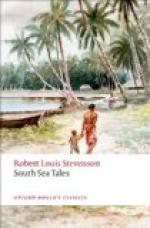My favourite haunt was opposite the hamlet, where was a landing in a cove under a lianaed cliff. The beach was lined with palms and a tree called the purao, something between the fig and mulberry in growth, and bearing a flower like a great yellow poppy with a maroon heart. In places rocks encroached upon the sand; the beach would be all submerged; and the surf would bubble warmly as high as to my knees, and play with cocoa-nut husks as our more homely ocean plays with wreck and wrack and bottles. As the reflux drew down, marvels of colour and design streamed between my feet; which I would grasp at, miss, or seize: now to find them what they promised, shells to grace a cabinet or be set in gold upon a lady’s finger; now to catch only maya of coloured sand, pounded fragments and pebbles, that, as soon as they were dry, became as dull and homely as the flints upon a garden path. I have toiled at this childish pleasure for hours in the strong sun, conscious of my incurable ignorance; but too keenly pleased to be ashamed. Meanwhile, the blackbird (or his tropical understudy) would be fluting in the thickets overhead.
A little further, in the turn of the bay, a streamlet trickled in the bottom of a den, thence spilling down a stair of rock into the sea. The draught of air drew down under the foliage in the very bottom of the den, which was a perfect arbour for coolness. In front it stood open on the blue bay and the Casco lying there under her awning and her cheerful colours. Overhead was a thatch of puraos, and over these again palms brandished their bright fans, as I have seen a conjurer make himself a halo out of naked swords. For in this spot, over a neck of low land at the foot of the mountains, the trade-wind streams into Anaho Bay in a flood of almost constant volume and velocity, and of a heavenly coolness.
It chanced one day that I was ashore in the cove, with Mrs. Stevenson and the ship’s cook. Except for the Casco lying outside, and a crane or two, and the ever-busy wind and sea, the face of the world was of a prehistoric emptiness; life appeared to stand stock-still, and the sense of isolation was profound and refreshing. On a sudden, the trade-wind, coming in a gust over the isthmus, struck and scattered the fans of the palms above the den; and, behold! in two of the tops there sat a native, motionless as an idol and watching us, you would have said, without a wink. The next moment the tree closed, and the glimpse was gone. This discovery of human presences latent overhead in a place where we had supposed ourselves alone, the immobility of our tree-top spies, and the thought that perhaps at all hours we were similarly supervised, struck us with a chill. Talk languished on the beach. As for the cook (whose conscience was not clear), he never afterwards set foot on shore, and twice, when the Casco appeared to be driving on the rocks, it was amusing to observe that man’s alacrity; death, he was persuaded, awaiting him upon the beach. It was more than a year later, in the Gilberts, that the explanation dawned upon myself. The natives were drawing palm-tree wine, a thing forbidden by law; and when the wind thus suddenly revealed them, they were doubtless more troubled than ourselves.




